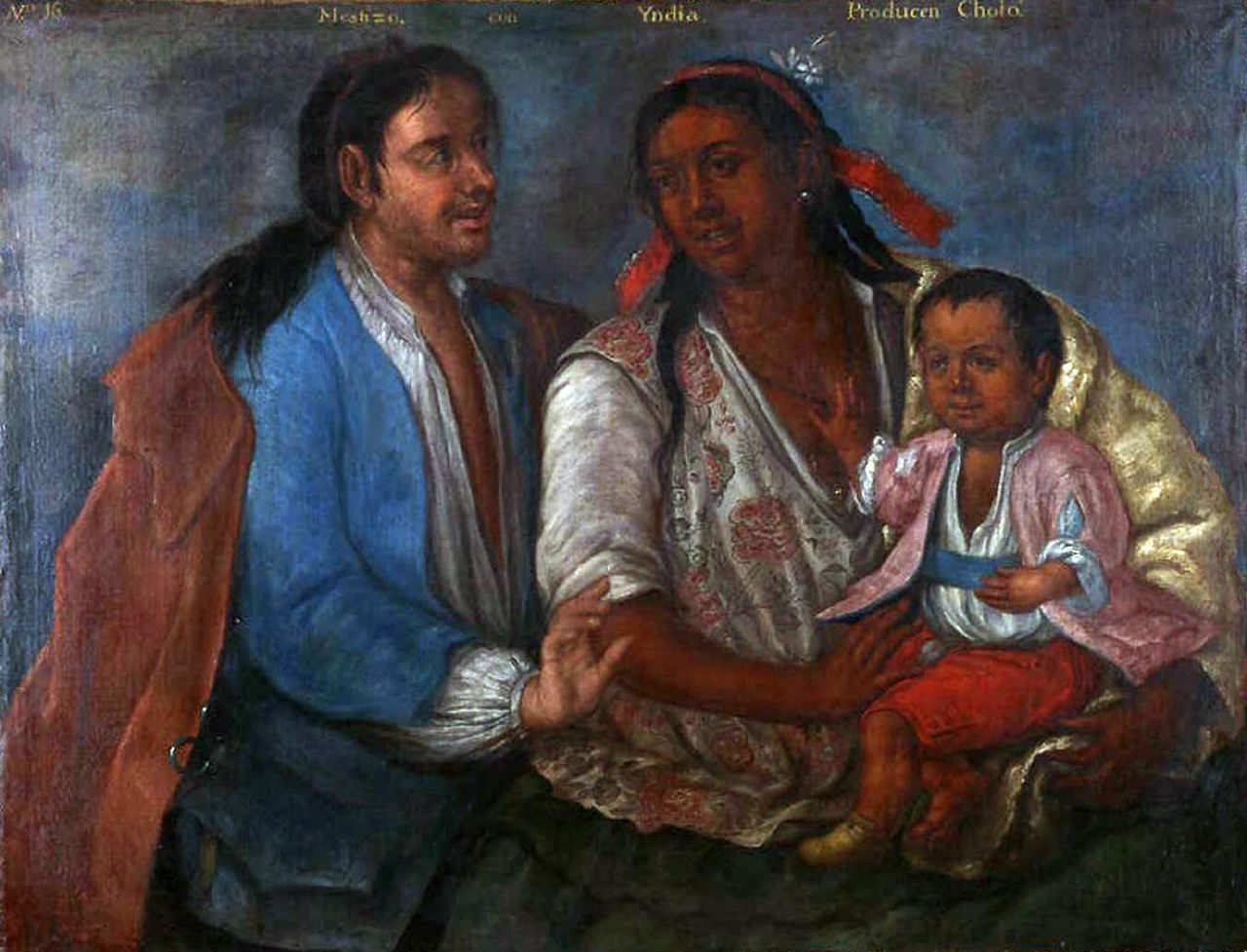
チョロ
Cholo

A
mestizo and indigenous parents' child was a cholo, traditionally. Casta
painting from colonial Peru, 1770.
☆ チョロ(スペイン語発音: [ˈtʃolo])は、さまざまな意味を持つあいまいなスペイン語の用語である。その起源は、ラテンアメリカにおけるスペイン帝国とその継承国における カースト制度(社会における非公式な血統による格付け)の一部として、混血の人々を多少軽蔑的に呼ぶ言葉であった。チョロという言葉は、もはや必ずしも民 族的な血統のみを指すわけではなく、常に否定的な意味で使われるわけでもない。チョロという言葉は、先住民の親とメスティーソの親を持つ人という本来の意味か ら、メキシコでは「ギャング」、南米諸国では侮辱的な意味(スペインにおけるチュロに類似)、あるいは米国ではチョロ・サブカルチャーの一部として「特定 のサブカルチャーのスタイルで身なりをしている人」を意味する場合もある。
Prayers And The Cholo Goth Movement - Noisey Meets
| Cholo (Spanish
pronunciation: [ˈtʃolo]) is a loosely defined Spanish term that has had
various meanings. Its origin is a somewhat derogatory term for people
of mixed-blood heritage in the Spanish Empire in Latin America and its
successor states as part of castas, the informal ranking of society by
heritage. Cholo no longer necessarily refers only to ethnic heritage,
and is not always meant negatively. Cholo can signify anything from its
original sense as a person with one indigenous parent and one Mestizo
parent, "gangster" in Mexico, an insult in some South American
countries (similar to chulo in Spain), or a "person who dresses in the
manner of a certain subculture" in the United States as part of the
cholo subculture.[1][2] |
チョロ(スペイン語発音: [ˈtʃolo])は、さまざまな意味を持つあいまいなスペイン語の用語である。その起源は、ラテンアメリカにおけるスペイン帝国とその継承国における カースト制度(社会における非公式な血統による格付け)の一部として、混血の人々を多少軽蔑的に呼ぶ言葉であった。チョロという言葉は、もはや必ずしも民 族的な血統のみを指すわけではなく、常に否定的な意味で使われるわけでもない。チョロという言葉は、先住民の親とメスチゾの親を持つ人という本来の意味か ら、メキシコでは「ギャング」、南米諸国では侮辱的な意味(スペインにおけるチュロに類似)、あるいは米国ではチョロ・サブカルチャーの一部として「特定 のサブカルチャーのスタイルで身なりをしている人」を意味する場合もある。[1][2] |
 Casta painting showing 16 hierarchically arranged, mixed-race groupings. The top left grouping uses cholo as a synonym for mestizo. Ignacio Maria Barreda, 1777. Real Academia Española de la Lengua, Madrid. |
 16の階層的に配置された混血グループを示すカスタ(階級)の絵画。左上のグループでは、チョロをメスティーソの同義語として使用している。イグナシオ・マリア・バレダ、1777年。スペイン王立言語アカデミー、マドリード。 |
| Historical usage Main article: Casta Further information: Spanish colonization of the Americas In his work Vocabulario en Lengua Castellana y Mexicana (1571), Fray Alonso de Molina reports that the word "cholo" or "xolo" derives from Nahuatl and means "paje, moço, criado o esclavo" ("page, waiter, servant or slave").[3] The term's use to describe a caste is first recorded in a Peruvian book published in 1609 and 1616, the Comentarios Reales de los Incas by Inca Garcilaso de la Vega. He writes (in Spanish) "The child of a Black male and an Indian female, or of an Indian male and Black female, they call mulato and mulata. The children of these they call cholos. Cholo is a word from the Barlovento Islas [later known as Windward Islands]; it means dog, not of the purebred variety, but of very disreputable origin; and the Spaniards use it for insult and vituperation".[4] Interestingly, the Mexican hairless dog is known as "xoloitzcuintli" or "xolo" in Nahuatl. In Ecuador, mestizas wearing indigenous attire in Ecuador were termed cholas. "Chola appears to have been a designation largely reserved for women and which, according to Jacques Poloni-Simard, was used to indicate mestiza women who had achieved an incipient degree of hispanization that was beyond the grasp of men, who were more firmly bound to their native communities by tribute obligations."[5][6] In Imperial Mexico, the terms cholo and coyote co-existed,[citation needed] indicating mixed Mestizo and indigenous ancestry. Under the casta designations of colonial Mexico, the term rarely appears; however, an eighteenth-century casta painting by Ignacio María Barreda shows the grouping Español, India, with their offspring a Mestizo or Cholo[7] Cholo as an English-language term dates at least to 1851 when it was used by Herman Melville in his novel Moby-Dick, referring to a Spanish speaking sailor, possibly derived from the Windward Islands reference mentioned above. Isela Alexsandra Garcia of the University of California at Berkeley writes that the term can be traced to Mexico, where in the early part of the last century it referred to "culturally marginal" mestizos and Native American origin.[8] During the War of the Pacific (1879–1883) Peruvians were contemptuously referred to as "cholos" by Chilean officers.[9] An article in the Los Angeles Express of April 2, 1907, headlined "Cleaning Up the Filthy Cholo Courts Has Begun in Earnest", uses the terms cholos and Mexicans interchangeably.[10] The term cholo courts was defined in The Journal of San Diego History as "sometimes little more than instant slums as shanties were strewn almost randomly around city lots in order to create cheap horizontal tenements."[11] |
歴史的な用法 詳細は:カスタ 関連情報:スペインによるアメリカ大陸植民地化 修道士モリーナの著書『Vocabulario en Lengua Castellana y Mexicana』(1571年)によると、「チョロ」または「ショロ」という語はナワトル語に由来し、「paje, moço, criado o esclavo」(「小姓、給仕、召使または奴隷」)を意味する。 この用語がカーストを表すのに使われた最初の記録は、1609年と1616年にペルーで出版されたインカ・ガルシラス・デ・ラ・ベガ著『インカ王家のコメ ント』である。彼は(スペイン語で)「黒人とインディオの女性、またはインディオの男性と黒人の女性の間に生まれた子供はムラートとムラータと呼ぶ。彼ら の子供たちはチョロと呼ばれている。チョロはバルロベント諸島(後にウィンドワード諸島として知られるようになった)の言葉で、純血種ではなく、非常に評 判の悪い犬を意味する。スペイン人は侮辱や悪口を言うときにこの言葉を使う」[4] 興味深いことに、メキシコの無毛犬はナワトル語で「ショロイスクンツリ」または「ショロ」と呼ばれている。 エクアドルでは、先住民の衣装を身にまとった混血の女性は「チョラ」と呼ばれていた。「チョラ」という呼称は主に女性に対して使われていたようであり、 ジャック・ポロニ=シマールによると、それは、貢納義務によって先住民のコミュニティに強く結びついている男性には理解できない程度のヒスパニック化を達 成した混血女性を示すために使われていたようだ」[5][6] メキシコ帝国では、チョロとコヨーテという用語が共存しており[要出典]、混血のメスティーソと先住民の血筋を示していた。植民地時代のメキシコにおける カースタの呼称では、この用語はほとんど登場しないが、イグナシオ・マリア・バレダによる18世紀のカースタの絵画では、スペイン人、インディオ、そして 彼らの子孫であるメスティーソまたはチョロのグループが描かれている[7] 英語の「チョロ」という用語は、少なくとも1851年にハーマン・メルヴィルが小説『白鯨』でスペイン語を話す水夫について言及したときに使用されたもの で、おそらく前述のウィンドワード諸島に関する記述に由来するものである。カリフォルニア大学バークレー校のIsela Alexsandra Garciaは、この用語はメキシコに起源をたどることができ、前世紀の初期には「文化的には周縁的な」混血人とネイティブアメリカンを指していたと書い ている。[8] 太平洋戦争(1879年~1883年)中、ペルー人はチリの将校たちから「チョロ」と軽蔑的に呼ばれていた。[9] 1907年4月2日付のロサンゼルス・エクスプレス紙の記事「汚いチョロ裁判所の清掃が本格的に開始」では、チョロとメキシコ人を同義語として使用してい る。[10] チョロ裁判所という用語は、サンディエゴ歴史ジャーナル誌で「安価な集合住宅を建設するために、区画の周辺にバラックがほぼ無秩序に散乱し、時には即席の スラム街と化す」と定義されている。[11] |
| Modern usage United States Main article: Cholo (subculture) Cholos, cholas and cholitas are used as informal slang terms in parts of the US, to refer to people of Peruvian, Bolivian, Mexican, and many others of descent, who usually are low-income and "tough", and may wear stereotypical clothes. This is usually used to refer to people who are born in different places.[2] Bolivia 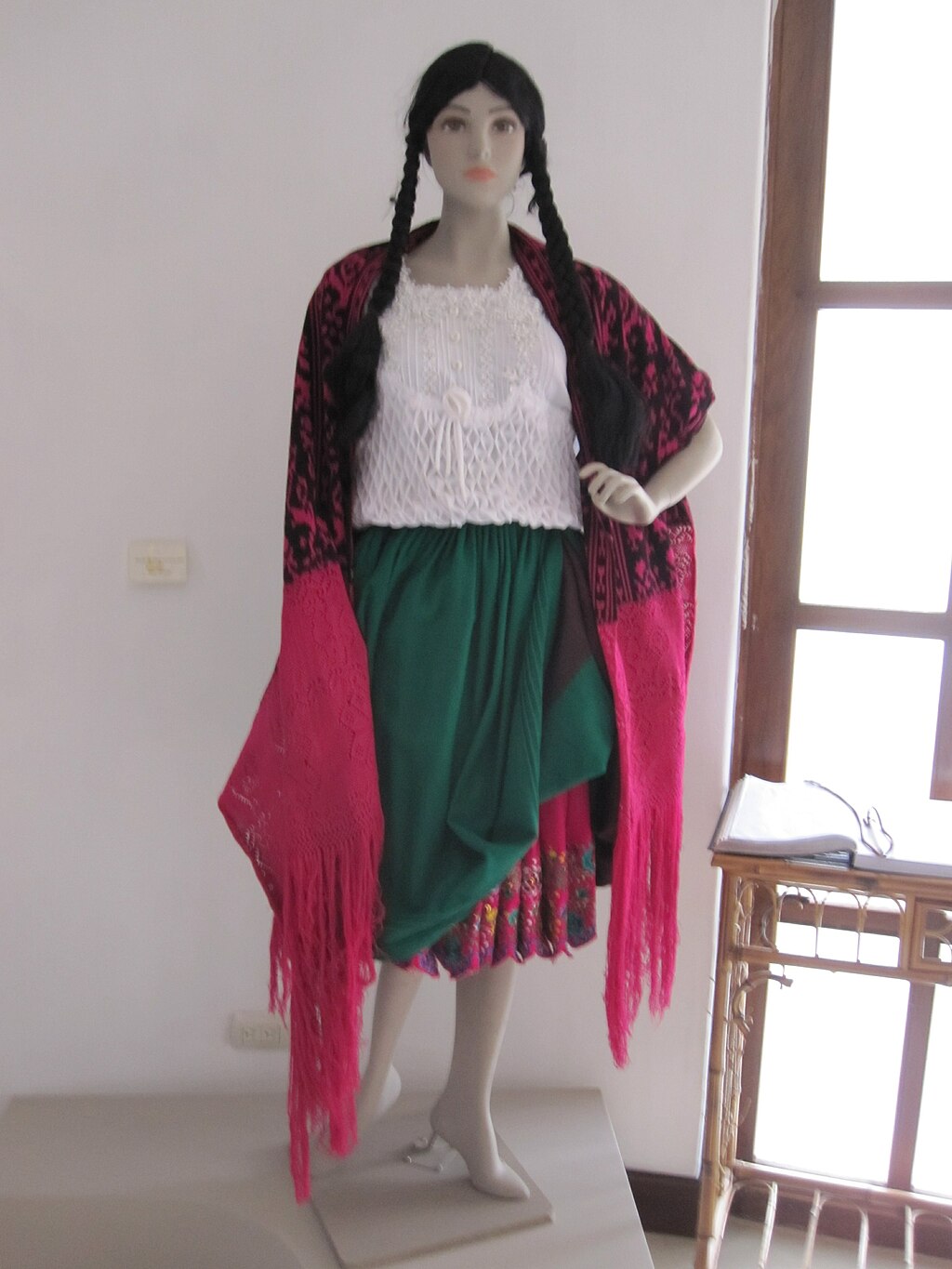 Typical dress of an Ecuadorian chola cuencana In Bolivia, "cholo" refers to people with various degrees of indigenous ancestry.[2] In Bolivia, the term "cholita" has overcome former prejudice and discrimination, and cholitas are now seen as fashion icons.[2] A "cholo" in Bolivia is a campesino (peasant, farmer) who moved to the city, and though the term was originally derogatory, has become more of a symbol of indigenous power. The word "cholo/a" is considered a common and/or official enough term in Bolivia such that "cholo" has been included as its own ethnic group option in demographic surveys conducted in the country. In these same surveys, the term had on occasion been used interchangeably with the term "mestizo."[12] Nevertheless, some locals still use cholo as a derogatory term. Ecuador Cholos pescadores are a group of traditional fishermen along the coasts of Ecuador.[citation needed] Peru In Peru, Mestizos with greater indigenous contributions are 27.7%: Those that would be in the range of 60% to 75% of indigenous contributions, characterized by presenting a tonality of tan, brown, and brunette skin with major features of indigenous ethnic groups. They are mostly descendants of Quechua peoples at around 23.7%; of other ethnic groups originating from the coast in 2%; of the Aymaras by 1.5%; of native ethnic groups of the jungle at 0.5%. Of the total of this sub-group around half are in the mountains, an important part of this segment due to migration are on the coast, usually in Lima, major urban centers and finally around a quarter (1/4) in the jungle. They are also called "cholos".[13] Mexico The cholo gangs started from the U.S. in the mid to late 1920s.[14] Cholo groups in Mexico were well established at least by the mid-1970s along the US-Mexico border, and in Central Mexico.[15] These were called by various names, such as "barrios", "clickas" and "gangas". They were typically seen as American Hispanics and not as Mexicans because of their dress and appearance, which was not traditionally worn Mexico. Many of these groups were formed by youths who had spent time in the United States and who returned with a different identity picked up in U.S. street life.[16][14] These groups mimic the organization of gangs in the United States, especially California, Texas and Chicago. Cholos have their own style of dress and speech. They are known for hand signals, tattoos and graffiti. Groups of cholos control various territories in the city. Most of the violence among these groups is over territory.[16] Well established Latino gangs from the United States (such as Norteños, Sureños, Latin Kings, 18th Street Gang and MS-13) have made a strong presence in Mexico through making alliances with local drug cartels based on particular regions or cities. 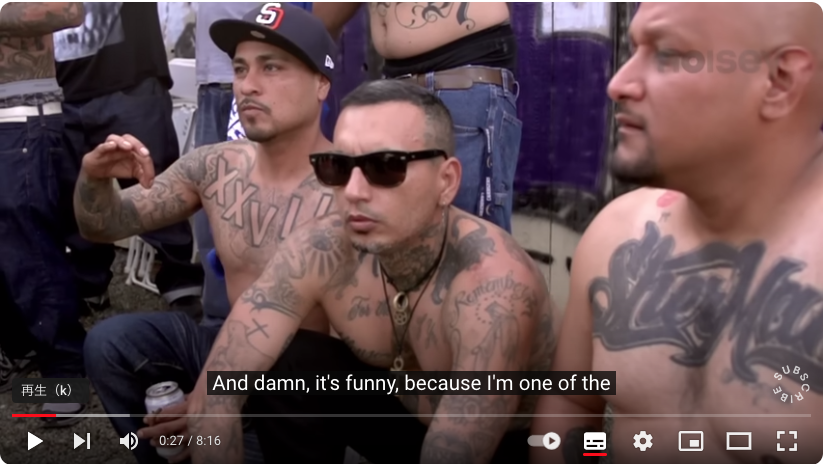 |
現代の用法 アメリカ合衆国 詳細は「チョロ (サブカルチャー)」を参照 アメリカ合衆国の一部では、ペルー、ボリビア、メキシコなど、その他多くの国々の血を引く人々を指す非公式な俗語として、「チョロ(Cholo)」、 「チョラ(Chola)」、「チョリータ(Cholita)」が用いられる。通常、低所得で「タフ」な人々を指し、ステレオタイプ的な服装をすることがあ る。これは通常、異なる場所で生まれた人々を指すために用いられる。[2] ボリビア  エクアドル人チョラの典型的な服装 ボリビアでは、「チョロ」は先住民の血を引く人々を指す。[2] ボリビアでは、「チョリータ」という言葉は以前の偏見や差別を克服し、今ではチョリータはファッションのアイコンとして見られている。[2] ボリビアにおける「チョロ」は、都市に移住したカンペシーノ(農民、農場労働者)を指し、この言葉はもともと侮蔑的な意味合いがあったが、今では先住民の 力の象徴として受け止められている。「チョロ」という言葉は、ボリビアでは一般的かつ公式な用語とみなされており、同国で行われた人口調査では「チョロ」 は独自の民族グループとして選択肢に含まれていた。これらの同じ調査では、この用語は「メスチゾ」という用語と交換可能に使用されることもあった。 [12] それにもかかわらず、一部の地元住民は今でも「チョロ」を侮蔑的な用語として使用している。 エクアドル Cholos pescadoresは、エクアドル沿岸の伝統的漁師のグループである。[要出典] ペルー ペルーでは、先住民の血統が大きいメスチソは27.7%である。先住民の血統が60%から75%の範囲にある人々で、褐色、茶色、黒髪のトーンを持ち、先 住民の民族の特徴を色濃く表している。彼らの大半はケチュア族の末裔で約23.7%、その他海岸地方出身の民族が2%、アイマラ族が1.5%、ジャングル 地方の先住民が0.5%である。このサブグループの総人口の約半分は山岳地帯に、移住によりこのセグメントの重要な部分を占める人々は海岸地帯、通常はリ マなどの主要都市に、そして最後にジャングル地帯に約4分の1(1/4)が居住している。彼らは「チョロ」とも呼ばれる。[13] メキシコ チョロギャングは1920年代半ばから後半にかけて米国から始まった。[14] メキシコのチョログループは少なくとも1970年代半ばまでに、米国とメキシコの国境沿い、およびメキシコ中央部で確立されていた。[15] これらは「バリオ」、「クリッカス」、「ガンガス」など、さまざまな名称で呼ばれていた。彼らは伝統的にメキシコでは着用されていない服装や外見をしてい たため、一般的にアメリカ系ヒスパニックと見なされ、メキシコ人とは見なされなかった。これらのグループの多くは、アメリカで過ごした経験があり、アメリ カのストリート・ライフで身につけた異なるアイデンティティを持ってメキシコに戻ってきた若者たちによって結成された。[16][14] これらのグループは、特にカリフォルニア、テキサス、シカゴのアメリカのギャングの組織を模倣している。チョロには独自の服装や話し方がある。彼らはハン ドサイン、入れ墨、落書きで知られている。 チョロのグループは、都市のさまざまな地域を支配している。 これらのグループ間の暴力のほとんどは、縄張り争いが原因である。[16] 米国で確立されたラテン系ギャング(ノルテーニョス、シュレニョス、ラテン・キングス、18番街ギャング、MS-13など)は、特定の地域や都市を基盤と する地元麻薬カルテルと手を組むことで、メキシコに強力な影響力を及ぼしている。  |
| Aymara ethnic group Caboclo Chicano Chulo (disambiguation) Coyote (racial category) Mixed Race Day Naco (slang) Pachuco Zambo |
アイマラ族 カボクロ チカーノ チュロ(曖昧さ回避) コヨーテ(人種カテゴリー) 混血の日(ブラジル) ナコ(俗語) パチューコ サンボ |
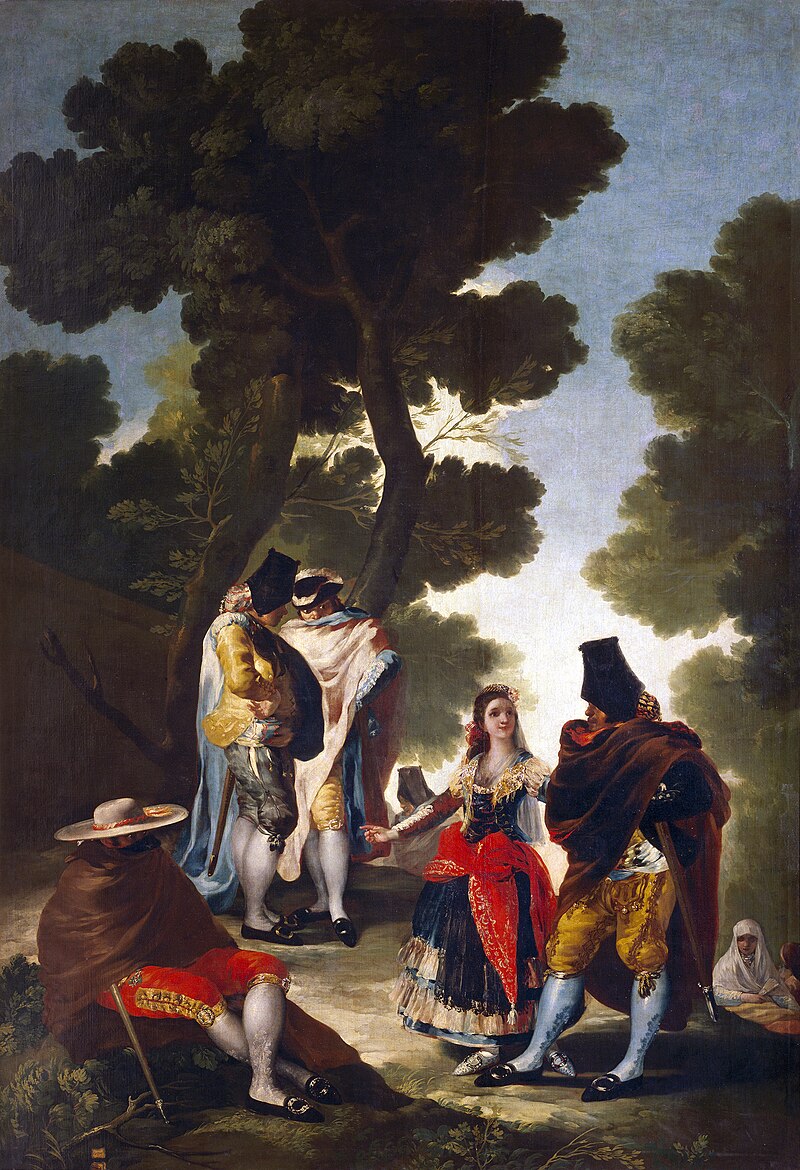 El paseo por Andalucía, by Francisco de Goya, depicts Majo and /or Maja- also manolo and manola, after the most popular names, were people from the lower classes of Spanish society, especially in Madrid, who distinguished themselves by their elaborate outfits and sense of style in dress and manners, as well as by their cheeky behavior. They flourished from the late 18th to early 19th century, and to some extent later. Majos and majas were one of the favorite subjects of some 19th-century Spanish painters. |
 フランシスコ・デ・ゴヤの「アンダルシアの散歩」には、マホ(またはマハ)とマノロ(またはマノラ)が描かれている。マホとマハは、特にマドリードで、 凝った衣装と服装やマナーのセンス、そして生意気な態度で知られたスペイン社会の下層階級の人々である。彼らは18世紀後半から19世紀初頭にかけて、そ してその後もいくらか繁栄した。マホスとマハスは、19世紀のスペイン人画家たちのお気に入りの題材のひとつであった。 |
| Coyote (fem. Coyota) (from
the Nahuatl word coyotl, coyote) is a colonial Spanish American racial
term for a mixed-race person casta that usually refers to a person born
of parents, one of whom a Mestizo (mixed Spanish + Indigenous) and the
other indigenous (indio). Representation The casta paintings by Miguel Cabrera (1763) show the place of the coyote in the idealized colonial racial hierarchy (sistema de castas).[1] In colonial Mexico, the term varied regionally, with "regional differences determin[ing] just how much native ancestry qualified a person to be a coyote."[2] -Katzew, Ilona. Casta Painting: Images of Race in Eighteenth-Century Mexico. New Haven: Yale University Press 2004. |
コヨーテ(女性形:コヨタ)は、ナワトル語のcoyotl(コヨーテ)に由来するスペイン語系アメリカ人の混血の人種を表す用語で、通常はメスティーソ(スペイン系と先住民の混血)と先住民の親を持つ人を指す。 表現 ミゲル・カブレラ(1763年)によるカースタの絵画は、理想化された植民地時代のカースタ階級制度におけるコヨーテの位置を示している。[1] 植民地時代のメキシコでは、この用語は地域によって異なり、「地域差によって、先住民の血統がどの程度コヨーテにふさわしいかが決定された」[2]。 |
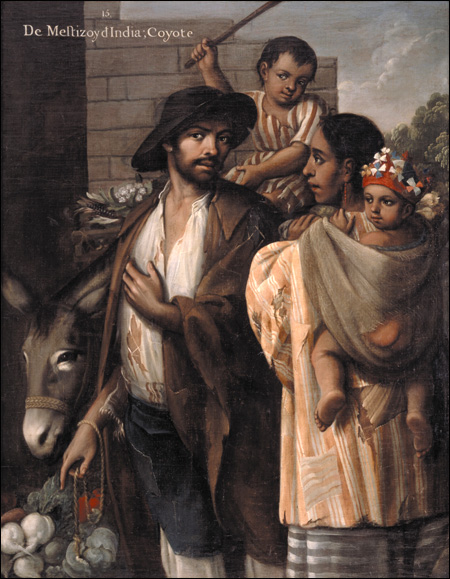 De Mestizo y de India; Coyote. Miguel Cabrera, 1763, oil on canvas, Waldo-Dentzel Art Center. |
|
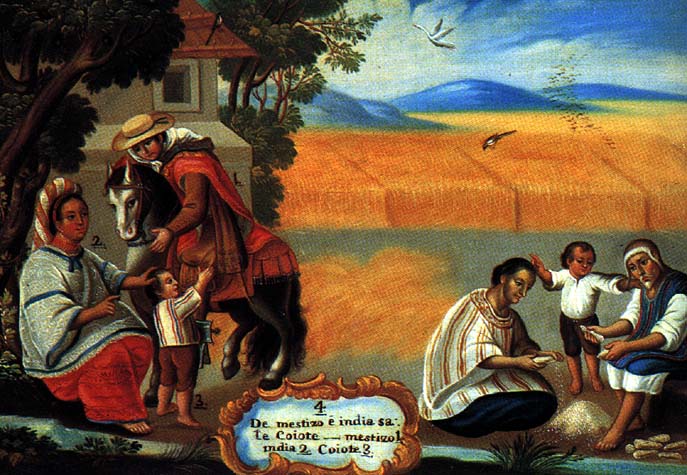 De mestizo e india, sale coiote. Anonymous, 18th century (From a Mestizo man and an Amerindian woman, a coyote is begotten). |
|
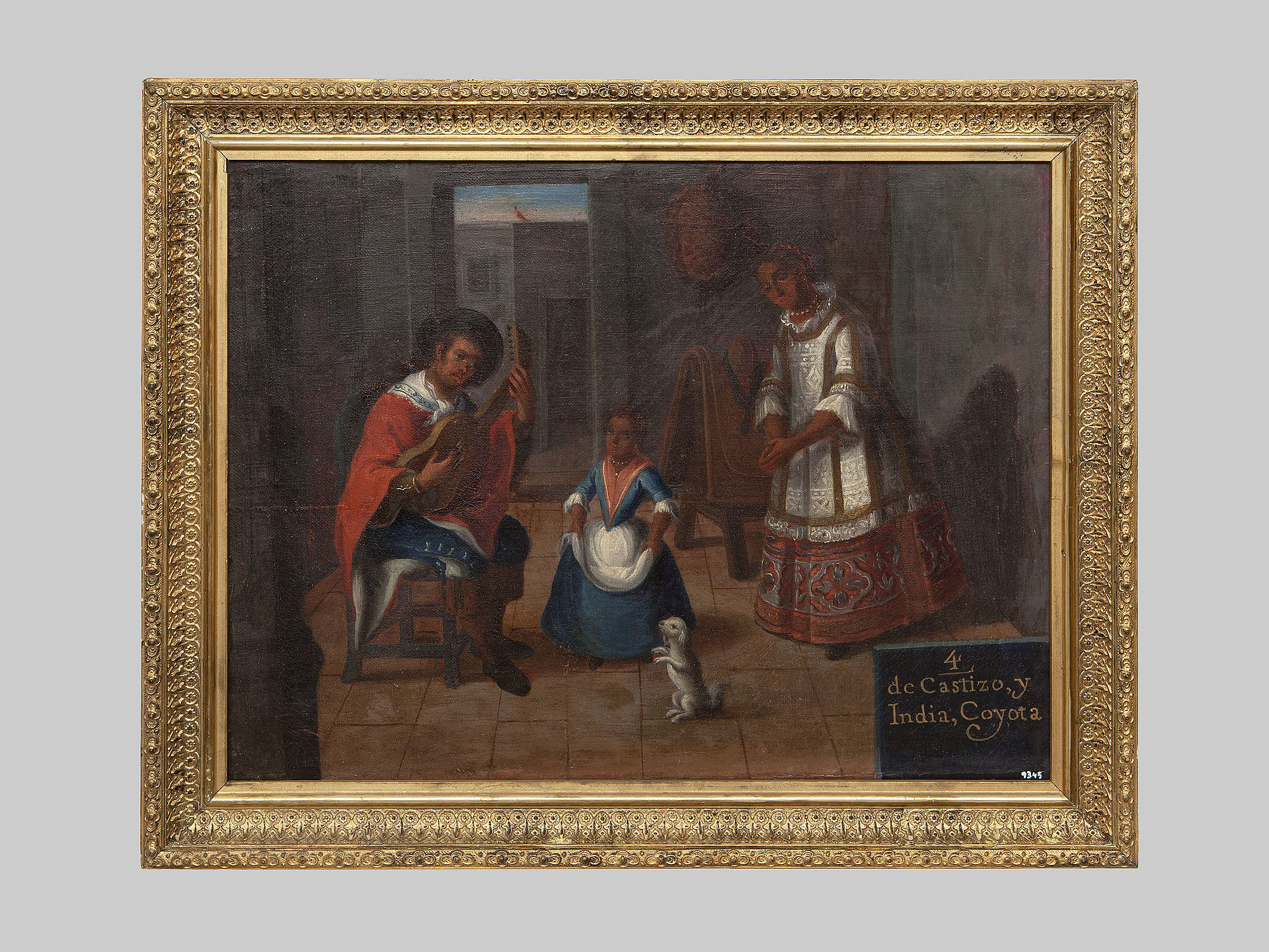 De Castizo y India, Coyota. Anonymous, 18th century Mexico. |
|
| Naco (fem. naca) is a pejorative
word often used in Mexican Spanish that may be translated into English
as "low-class", "uncultured", "vulgar" or "uncivilized ".[1] A naco (Spanish: [ˈnako] ⓘ) is usually associated with lower socio-economic classes. Although, it is used across all socioeconomic classes, when associated with middle - upper income people, it means “vulgar”, “bad taste”, and “pretentious”. Definition and usage The Cuban lexicographer Felix Ramos y Duarte, in his Diccionario de Mejicanísmos (1895), records the word for the first time. He explains it as usual in Tlaxcala (Mexico) and defines it with the following terms: "Indian dressed in blue cotton, white underpants and guaraches". The term naco is generally used to describe people, behaviors or aesthetic choices seen as unrefined or unsophisticated, often in a comic way. As a person, the "naco" may display a general lack of refinement by adopting a "gangster mentality", unrefined verbal expressions or slang, peculiar accents, lack of social manners, or comically bad taste. The word likely originated as a contraction of "totonaco" referring to the members of the Totonac people, which is sometimes used as a disparaging term for indigenous people in general.[2] The term is often associated to lower social classes, but it is also used as an elitist expression from the educated to describe the uneducated, and among the middle and upper classes as a synonym of bad taste. In many situations, the word has derogatory intentions.[3] The Mexican definition of a naco may be roughly analogous to the American redneck or hillbilly, the British chav, the Australian bogan or the French beauf. Sociolinguistic use In recent decades, the middle and upper classes in Mexico have experienced a rapid expansion due to, among other things, economic development and urbanization. The new middle class and "nouveau riche" have entered the competition on status symbols such as cars, houses, and jewelry, which have given rise to the term "naco" as a form of cultural or economic elitism. Mexicans of higher status often see extravagant displays of wealth as making a person more naco, in that they make spectacles of themselves by overcompensating for lower social status. The word naco is mostly used for ignorant people. Within the last few decades, there have been movements in embracing the term and redefining it for self identity and pride. The title of the 1987 album by the band Botellita de Jerez is: "Naco es chido", which means "being naco is cool". |
ナコ(女性形:ナサ)は、メキシコ・スペイン語でよく使われる軽蔑的な言葉で、英語では「低級」、「無教養」、「下品」、「未開」などと訳される。 ナコ(スペイン語: [ˈnako] ⓘ)は、通常、社会経済的地位の低い階級と関連付けられる。ただし、あらゆる社会経済的地位の人々に使用されるが、中~高所得者層に関連して使用される場合は、「下品」、「悪趣味」、「気取り屋」という意味になる。 定義と用法 キューバの辞書編集者フェリックス・ラモス・イ・ドゥアルテは、1895年に出版した『Diccionario de Mejicanísmos(メキシコ俗語辞典)』で初めてこの語を記録した。彼は、メキシコのトラスカラ州では通常、この語を「青い木綿の服に白い下着、 グアラッチ(皮草履)を履いたインディオ」と定義している。 ナコという用語は一般的に、粗野または洗練されていないと見なされる人々、行動、または美的な選択を表現するために使用され、しばしばコミカルな意味合い で使われる。「ナコ」は、ギャングのような考え方や粗野な言葉遣い、スラング、独特なアクセント、社会的なマナーの欠如、あるいは滑稽なほど趣味が悪いな ど、洗練されていないことを示す。この言葉は、トトナック族のメンバーを指す「トトナコ」が短縮されたものとして生まれた可能性が高い。トトナック族は、 先住民全体を侮辱する言葉として使われることもある。 この用語は、しばしば社会的地位の低い階級と関連付けられるが、教養のある人々が教養のない人々を表現するエリート主義的な表現としても使用され、中流階 級や上流階級の間では、悪趣味の代名詞としても使用される。多くの状況において、この言葉には軽蔑的な意図がある。[3] メキシコにおけるナコの定義は、アメリカにおけるレッドネックやヒルビリー、イギリスにおけるチャヴ、オーストラリアにおけるボガン、フランスにおけるボーフとほぼ同義である。 社会言語学的な用法 ここ数十年、メキシコの中流階級および上流階級は、経済発展や都市化などにより急速に拡大した。新興中流階級や成り金が、車や家、宝石などのステータスシ ンボルを巡る競争に参入したことで、文化的あるいは経済的なエリート主義を表す言葉として「ナコ」という言葉が生まれた。地位の高いメキシコ人は、贅沢な 富の誇示は、社会的地位の低さを補うために見せびらかす行為であり、その人をより「ナコ」にする、と考えることが多い。「ナコ」という言葉は、主に無知な 人に対して使われる。 ここ数十年の間、この言葉を積極的に受け入れ、自己のアイデンティティと誇りのために再定義しようという動きがある。1987年に発表されたバンド、ボテ リータ・デ・ヘレスのアルバムのタイトルは「ナコ・エス・チード」であり、これは「ナコであることはクールだ」という意味である。 |
| Bogan Chav Cholo Dres Gopnik Greaser Lumpenproletariat Mexican Spanish Ratchet White trash Redneck Anti-intellectualism |
ボガン チャブ チョロ ドレス ゴプニク グリーサー ルンペンプロレタリアート メキシコ系スペイン語 ラチェット ホワイトトラッシュ レッドネック 反知性主義 |
| https://en.wikipedia.org/wiki/Naco_(slang) |
|
16の階層的に配置された混血グループを示すカスタ(階級)の絵画。左上のグループでは、チョロをメスティーソの同義語として使用している。イグナシオ・マリア・バレダ、1777年。スペイン王立言語アカデミー、マドリード。
リ ンク
文 献
そ の他の情報
Copyleft, CC, Mitzub'ixi Quq Chi'j, 1996-2099
☆
 ☆
☆